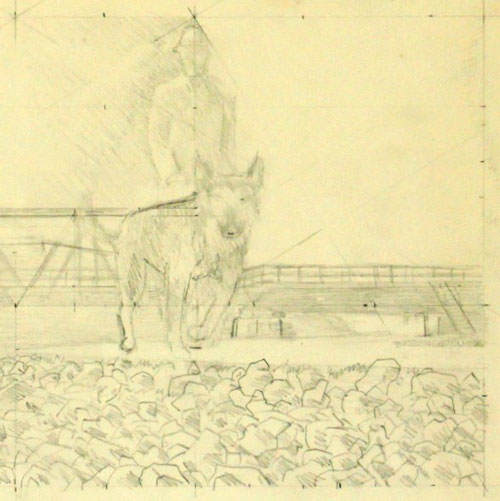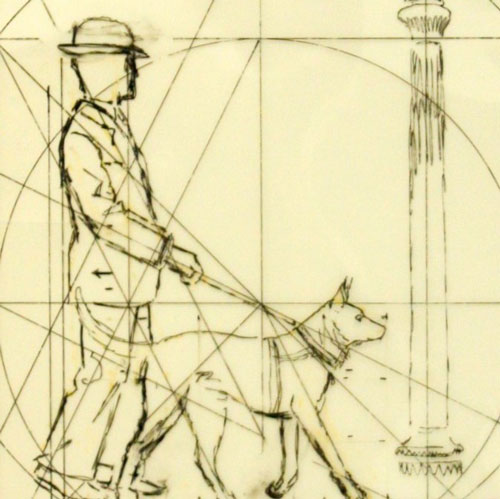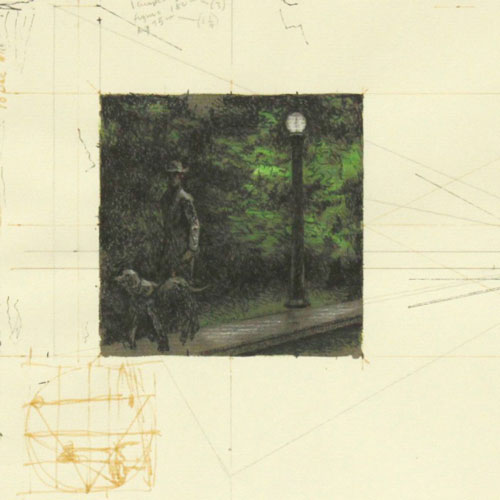A Digital Exhibit of Fine Art by Canadian Artists
A Digital Exhibit of Fine Art by Canadian Artists

ALEX COLVILLE
David Alexander Colville (1920 – 2013) was an iconic Canadian painter, printmaker and veteran who transformed the seemingly mundane figures and events of everyday life into archetypes of the modern condition.
Born in 1920 in Toronto, Ontario, Colville moved with his family at age seven to St. Catharines, and then to Amherst, Nova Scotia in 1929. He attended Mount Allison University from 1938 to 1942, graduating with a Bachelor of Fine Arts.
He married Rhoda Wright in 1942 and enlisted in the Canadian Army in the infantry, eventually earning the rank of lieutenant. He painted in Yorkshire and took part in the Royal Canadian Navy’s landings in southern France. He was then attached to the 3rd Canadian Division. In 1944, he was made a war artist. His unit relieved the 82nd Airborne Division at Nijmegen, Netherlands in mid-September 1944 during Operation Market Garden and remained there until the following February. He continued on to tours in the Netherlands and Germany, where he was also tasked with depicting the horrors of the Bergen-Belsen concentration camp.
Colville returned to New Brunswick after the war and became a faculty member with the Fine Arts Department at Mount Allison University where he taught from 1946 to 1963. He left teaching to devote himself to painting and print-making full-time from a studio in his home on York Street; this building is now named The Colville House.
Colville's works are highly representational reflections of a world which is at once filled with the joyful and the beautiful, the disturbing and the dangerous. He has changed his medium a number of times, from oil to tempera to oil and synthetic resin, and after 1963 to acrylic polymer emulsion. He follows a long, careful process for each composition, taking precise measurements and proportioning these to an underlying geometric scheme. He works on only one composition at a time, and since the 1950s has produced only three or four paintings or serigraphs a year.
In 1966, his works along with those of Yves Gaucher and Sorel Etrog represented Canada at the Venice Biennale. A year later, Colville was made an Officer of the Order of Canada, elevated to Companion in 1982, the order’s highest level. He lived in St. Catharines, Ontario for three years before moving to his wife’s hometown of Wolfville. In 1981 he was appointed university chancellor of Acadia University serving in that role until 1991.
Colville exhibited extensively across Canada and internationally including at the Tate Gallery in London and the Beijing Exhibition Centre in Beijing. In 1983, an international touring retrospective of his work was organized by the Art Gallery of Ontario.
Colville’s work is found in many collections including the Art Gallery of Nova Scotia, the Cape Breton University Art Gallery in Sydney, Nova Scotia, the New Brunswick Museum, Saint John, the Museum of Modern Art in New York, the Musée National d’Art Moderne in Paris, the National Gallery of Canada in Ottawa, the Centre National d’Art et de Culture Georges Pompidou in Paris, the Wallraf-Richartz Museum in Cologne and the Kestnergesellschaft in Hanover, Germany.
For more on the artist, visit alexcolville.ca

ALEX COLVILLE
David Alexander Colville (1920 – 2013) was an iconic Canadian painter, printmaker and veteran who drew his inspiration from the world around him, transforming the seemingly mundane figures and events of everyday life into archetypes of the modern condition. Born in 1920 in Toronto, Ontario, Colville moved with his family at age seven to St. Catharines, and then to Amherst, Nova Scotia in 1929. He attended Mount Allison University from 1938 to 1942, graduating with a Bachelor of Fine Arts.
He married Rhoda Wright in 1942 and enlisted in the Canadian Army in the infantry, eventually earning the rank of lieutenant. He painted in Yorkshire and took part in the Royal Canadian Navy’s landings in southern France. He was then attached to the 3rd Canadian Division. In 1944, he was made a war artist. His unit relieved the 82nd Airborne Division at Nijmegen, Netherlands in mid-September 1944 during Operation Market Garden and remained there until the following February. He continued on to tours in the Netherlands and Germany, where he was also tasked with depicting the horrors of the Bergen-Belsen concentration camp.
Colville returned to New Brunswick after the war and became a faculty member with the Fine Arts Department at Mount Allison University where he taught from 1946 to 1963. He left teaching to devote himself to painting and print-making full-time from a studio in his home on York Street; this building is now named Colville House.
Colville's works are highly representational reflections of a world which is at once filled with the joyful and the beautiful, the disturbing and the dangerous. He has changed his medium a number of times, from oil to tempera to oil and synthetic resin, and after 1963 to acrylic polymer emulsion. He follows a long, careful process for each composition, taking precise measurements and proportioning these to an underlying geometric scheme. He works on only one composition at a time, and since the 1950s has produced only three or four paintings or serigraphs a year.
In 1966, his works along with those of Yves Gaucher and Sorel Etrog represented Canada at the Venice Biennale. A year later, Colville was made an Officer of the Order of Canada, elevated to Companion in 1982, the order’s highest level. He lived in St. Catharines, Ontario for three years before moving to his wife’s hometown of Wolfville. In 1981 he was appointed university chancellor of Acadia University serving in that role until 1991.
Colville exhibited extensively across Canada and internationally including at the Tate Gallery in London and the Beijing Exhibition Centre in Beijing. In 1983, an international touring retrospective of his work was organized by the Art Gallery of Ontario.
Colville’s work is found in many collections including the Art Gallery of Nova Scotia, the Cape Breton University Art Gallery in Sydney, Nova Scotia, the New Brunswick Museum, Saint John, the Museum of Modern Art in New York, the Musée National d’Art Moderne in Paris, the National Gallery of Canada in Ottawa, the Centre National d’Art et de Culture Georges Pompidou in Paris, the Wallraf-Richartz Museum in Cologne and the Kestnergesellschaft in Hanover, Germany.
For more on the artist, visit alexcolville.ca
Chaplin

Dog, Man and Bridge

Night - Street Light and Tree

Nightwalk

Nightwalk II

Nightwalk III
